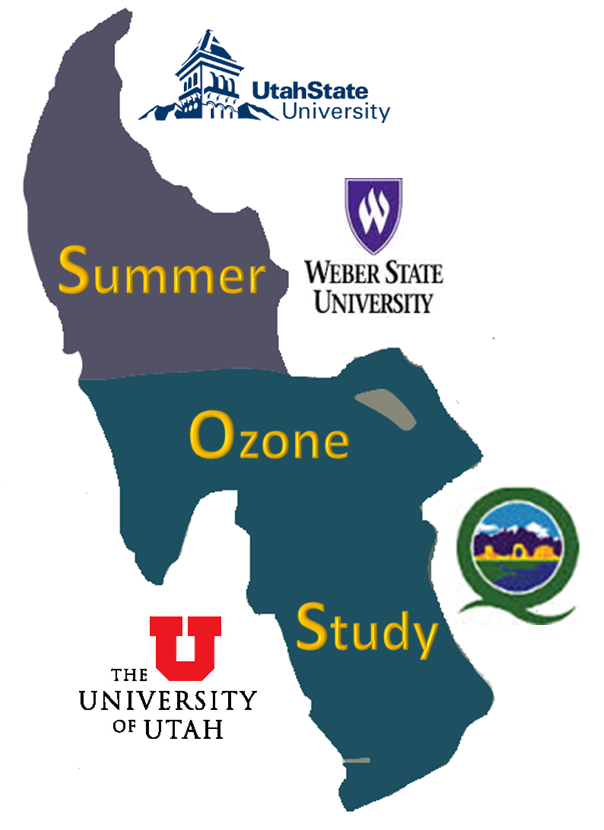Wasatch Front Winter Inversion Measurement Campaigns.
UWFPS 2017 = Utah Winter Fine Particulate Study 2017 Overview.
Winter Particulate Study 2017 Results.
Salt Lake Valley Winter Inversion Study 2016 Overview.
Winter Particulate Study 2016 Results.
Images and initial data from the WSU Physics team can be found here.
Links to data from all the research teams can be found at the U of U Salt Lake Valley PM2.5 Pollution Study website.
This study is a joint effort organized by the Utah Department of Environmental Quality's Division of Air Quality. The funded agencies are the University of Utah Department of Atmospheric Sciences, the Utah State University Civil and Environmental Engineering Department, and the Weber State University Department of Physics.
Our goal is to better understand the evolution and dynamics of the air during the dreaded Winter Inversions (Persistant Cold Air Pools), especially when small particulates (PM2.5) are trapped and a clear human health hazzard is created.
Here are some useful links:
Location of primary flight operations is Larry H. Miler Sports Complex at approximately 4260 S 1300 E, Millcreek, Salt Lake City.
Inversion Predictor from USU's Climate Center.
NOAA/NWS Weather forecast for our aerostat flight location (4260 S 1300 E, Millcreek (Salt Lake City), UT 84124).
Nearby Weather Underground private weather station and forecast.
Great Salt Lake Summer Ozone Study (SO3S)
 This
study is a massive effort to create the best ever data set of the daily
and summer long ozone evolution and the impact of Great Salt Lake. Most
of Utah's population is concentrated along the Wasatch Front in a large
basin known as the Great Basin.
This
study is a massive effort to create the best ever data set of the daily
and summer long ozone evolution and the impact of Great Salt Lake. Most
of Utah's population is concentrated along the Wasatch Front in a large
basin known as the Great Basin.
There will be a large number of fixed stations making continuous readings all day long.
There will be several ozone sensors that will be moving around the Salt Lake City and GSL area periodically.
There will also be three Intensive Operational Periods (IOP). Typically we will be targetting 2 or 3 days within the IOP, depending on weather. The Friday before will be the initial Go/No-Go call depending on weather and wildfires. In all cases the following week will be the backup. Each operational day during the IOP will get a Go/No-Go decision by noon of the preceding day.
IOP1 = June 16-19
IOP2 = July 13-17
IOP3 = August 10-14 or 17-21 (still to be determined)
During these three periods we will be making massive numbers of ozone measurements. For full details please go to the official SO3S website.
As an overview, during these three periods measurements such as the following will be attempted.
University of Utah (Lead agency along with the Utah Department of Environmental Quality's Division of Air Quality): The Nerdmobile will drive back and forth along the south and east perimeter of GSL. A team will drive back and forth along the Union Pacific causeway. Hopefully, a team will work with the KSL helicopter to fly circles around the lake.
Weber State University: Moored aerostat flights with both an ozonesonde and our AtmoSniffer (collectively known as a tethersonde) will be repeatedly made from ground level to 500 feet AGL. The team will join with the Weber County Sheriff's Office Search and Rescue Airboat Team to make transects across Great Salt Lake. A second ozonesonde/Atmosniffer will possibly run under a second aerostat moved across the lake or a combination of downtown Ogden and the WSU campus. We might launch several free flying ozonesondes to the stratosphere to obtain full column ozone measurements. Click here for primary aerostat flight details including aviation maps.
Location of the Ogden Bay Waterfowl Management Area location where the aerostat will fly and the location of a Utah DAQ fixed site air monitoring station:
Coordinates in three formats, I'll provide a map soon:
41.136770 N, 112.179734 W (You can cut and paste this format into Google
Maps.)
41° 08.20620' N, 112° 10.78404' W
41° 08' 12.3720" N, 112° 10' 47.0424" W
Utaht State University: USU will fly long duration, fixed wing, UAV flights over GSL with various sensors on board. Possibly including an AtmoSniffer.
Helpful Links:
Statewide surface winds and other data. This is a very cool weather website.
University of Utah, Department of Atmospheric Sciences
Utah State University: AggieAir (UAV information) and the Utah Climate Center
Ozonesonde Free Flight Prediction.
June 17, Day 2 of IOP1 for GSL SO3S:
